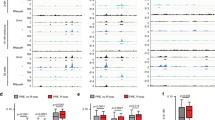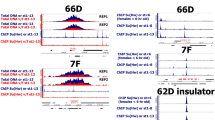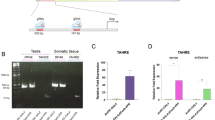Abstract
There is considerable interest in the developmental, temporal and tissue-specific patterns of DNA replication in metazoans1,2. Site-specific DNA replication at the chorion loci in Drosophila follicle cells leads to extensive gene amplification, and the organization of the cis-acting DNA elements that regulate this process may provide a model for how such regulation is achieved3. Two elements important for amplification of the third chromosome chorion gene cluster, ACE3 and Ori-β, are directly bound by Orc4,5,6 (origin recognition complex), and two-dimensional gel analysis has revealed that the primary origin used is Ori-β (refs 7–9). Here we show that the Drosophila homologue of the Myb (Myeloblastosis) oncoprotein family is tightly associated with four additional proteins, and that the complex binds site-specifically to these regulatory DNA elements. Drosophila Myb is required in trans for gene amplification, showing that a Myb protein is directly involved in DNA replication. A Drosophila Myb binding site, as well as the binding site for another Myb complex member (p120), is necessary in cis for replication of reporter transgenes. Chromatin immunoprecipitation experiments localize both proteins to the chorion loci in vivo. These data provide evidence that specific protein complexes bound to replication enhancer elements work together with the general replication machinery for site-specific origin utilization during replication.
This is a preview of subscription content, access via your institution
Access options
Subscribe to this journal
Receive 51 print issues and online access
$199.00 per year
only $3.90 per issue
Buy this article
- Purchase on Springer Link
- Instant access to full article PDF
Prices may be subject to local taxes which are calculated during checkout





Similar content being viewed by others
References
Gilbert, D. M. Making sense of eukaryotic DNA replication origins. Science 294, 96–100 (2001)
Bell, S. P. The origin recognition complex: from simple origins to complex functions. Genes Dev. 16, 659–672 (2002)
Calvi, B. R. & Spradling, A. C. Chorion gene amplification in Drosophila: A model for metazoan origins of DNA replication and S-phase control. Methods 18, 407–417 (1999)
Austin, R. J., Orr-Weaver, T. L. & Bell, S. P. Drosophila ORC specifically binds to ACE3, an origin of DNA replication control element. Genes Dev. 13, 2639–2649 (1999)
Bosco, G., Du, W. & Orr-Weaver, T. L. DNA replication control through interaction of E2F-RB and the origin recognition complex. Nature Cell Biol. 3, 289–295 (2001)
Chesnokov, I., Remus, D. & Botchan, M. Functional analysis of mutant and wild-type Drosophila origin recognition complex. Proc. Natl Acad. Sci. USA 98, 11997–12002 (2001)
Heck, M. M. & Spradling, A. C. Multiple replication origins are used during Drosophila chorion gene amplification. J. Cell Biol. 110, 903–914 (1990)
Delidakis, C. & Kafatos, F. C. Amplification enhancers and replication origins in the autosomal chorion gene cluster of Drosophila. EMBO J. 8, 891–901 (1989)
Lu, L., Zhang, H. & Tower, J. Functionally distinct, sequence-specific replicator and origin elements are required for Drosophila chorion gene amplification. Genes Dev. 15, 134–146 (2001)
Peters, C. W., Sippel, A. E., Vingron, M. & Klempnauer, K. H. Drosophila and vertebrate myb proteins share two conserved regions, one of which functions as a DNA-binding domain. EMBO J. 6, 3085–3090 (1987)
Stober-Grasser, U. et al. The Myb DNA-binding domain is highly conserved in Dictyostelium discoideum. Oncogene 7, 589–596 (1992)
Calvi, B. R., Lilly, M. A. & Spradling, A. C. Cell cycle control of chorion gene amplification. Genes Dev. 12, 734–744 (1998)
Manak, J. R., Mitiku, N. & Lipsick, J. S. Mutation of the Drosophila homologue of the Myb protooncogene causes genomic instability. Proc. Natl Acad. Sci. USA 99, 7438–7443 (2002)
Margolis, J. & Spradling, A. Identification and behavior of epithelial stem cells in the Drosophila ovary. Development 121, 3797–3807 (1995)
Duffy, J. B., Harrison, D. A. & Perrimon, N. Identifying loci required for follicular patterning using directed mosaics. Development 125, 2263–2271 (1998)
Suzanne, M., Perrimon, N. & Noselli, S. The Drosophila JNK pathway controls the morphogenesis of the egg dorsal appendages and micropyle. Dev. Biol. 237, 282–294 (2001)
Fitzpatrick, C. A., Sharkov, N. V., Ramsay, G. & Katzen, A. L. Drosophila myb exerts opposing effects on S phase, promoting proliferation and suppressing endoreduplication. Development 129, 4497–4507 (2002)
Ganter, B. & Lipsick, J. S. Myb and oncogenesis. Adv. Cancer Res. 76, 21–60 (1999)
Gossen, M., Pak, D. T., Hansen, S. K., Acharya, J. K. & Botchan, M. R. A Drosophila homolog of the yeast origin recognition complex. Science 270, 1674–1677 (1995)
Ausubel, F. M., et al. Current Protocols in Molecular Biology (Wiley and Sons, New York, 1987)
Agrawal, A. & Schatz, D. G. RAG1 and RAG2 form a stable postcleavage synaptic complex with DNA containing signal ends in V(D)J recombination. Cell 89, 43–53 (1997)
Harlow, E. & Lane, D. Antibodies: A Laboratory Manual (Cold Spring Harbor Laboratory Press, Plainview, New York, 1989)
Voitenleitner, C. & Botchan, M. E1 protein of bovine papillomavirus type 1 interferes with E2 protein-mediated tethering of the viral DNA to mitotic chromosomes. J. Virol. 76, 3440–3451 (2002)
Rio, D. C. & Rubin, G. M. Identification and purification of a Drosophila protein that binds to the terminal 31-base-pair inverted repeats of the P transposable element. Proc. Natl Acad. Sci. USA 85, 8929–8933 (1988)
Royzman, I., Austin, R. J., Bosco, G., Bell, S. P. & Orr-Weaver, T. L. ORC localization in Drosophila follicle cells and the effects of mutations in dE2F and dDP. Genes Dev. 13, 827–840 (1999)
Orr-Weaver, T. L. Drosophila chorion genes: cracking the eggshell's secrets. Bioessays 13, 97–105 (1991)
Acknowledgements
We thank B. Calvi, J. Tower, J. Kadonaga, D. Remus, P. Lewis and K. Fekete for advice, materials and technical contributions to our experiments. This work was supported by a fellowship from the Cancer Research Fund of the Damon Runyon-Walter Winchell Foundation (E.L.B.), and by the National Institutes of Health (J.S.L. and M.R.B.).
Author information
Authors and Affiliations
Corresponding author
Ethics declarations
Competing interests
The authors declare that they have no competing financial interests.
Rights and permissions
About this article
Cite this article
Beall, E., Manak, J., Zhou, S. et al. Role for a Drosophila Myb-containing protein complex in site-specific DNA replication. Nature 420, 833–837 (2002). https://doi.org/10.1038/nature01228
Received:
Accepted:
Issue Date:
DOI: https://doi.org/10.1038/nature01228
This article is cited by
-
NetREX-CF integrates incomplete transcription factor data with gene expression to reconstruct gene regulatory networks
Communications Biology (2022)
-
Anatomy and evolution of a DNA replication origin
Chromosoma (2021)
-
NF-κB upregulates glutamine-fructose-6-phosphate transaminase 2 to promote migration in non-small cell lung cancer
Cell Communication and Signaling (2019)
-
Nitrogen-dependent coordination of cell cycle, quiescence and TAG accumulation in Chlamydomonas
Biotechnology for Biofuels (2019)
-
Genome-wide analysis of gene regulation mechanisms during Drosophila spermatogenesis
Epigenetics & Chromatin (2018)
Comments
By submitting a comment you agree to abide by our Terms and Community Guidelines. If you find something abusive or that does not comply with our terms or guidelines please flag it as inappropriate.



